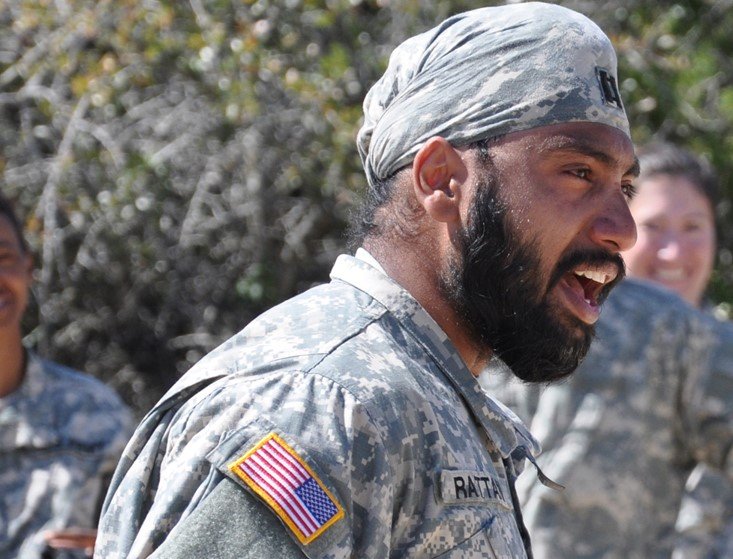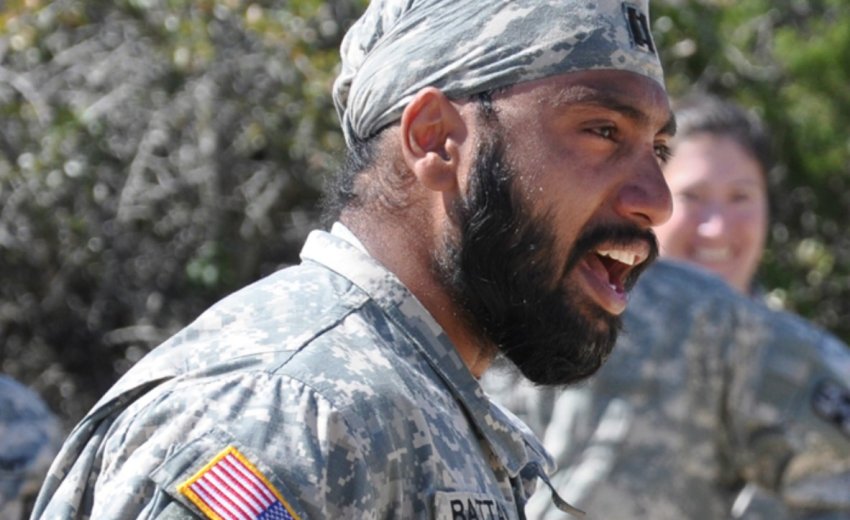
Since 2011, gay service members have openly served in the U.S. military. In 2016, service women will be able to compete for all combat positions. Within the next six months, transgender service members may be granted the right to serve openly. We are in a period of significant expansion of rights for specific subsets of the military population. Yet adherents of Sikhism, the world’s fifth-largest religion, have remained actively excluded from service since 1981.
Though Sikhs have been seeking to regain the right to serve in the U.S. military for decades, the issue has taken on new renewed visibility in the last few months amidst the wave of post-Paris and post-San Bernardino Islamophobia in the United States. Mistaken by ignorant bigots for Muslims — and historically targeted in their own right — a number of Sikh men in the United States have suffered severe verbal and physical abuse, while Sikh temples have been vandalized. This is nothing new for the estimated 500,000 Sikhs in the United States. According to the Sikh Coalition, more than 300 physical attacks against Sikhs were reported in the first month after September 11, 2001. The worst recent attack came in 2012, when a white supremacist Army veteran rampaged through a Sikh temple in Wisconsin, killing six and wounding three.
While anti-Islam sentiment in itself is unwelcome, the fact that Americans can’t tell a Sikh from a Muslim — a 2013 study found that half of Americans thought Sikhism was a sect of Islam and that 70 percent couldn’t identify a Sikh in a photo — is indicative of a general lack of awareness about the religion even though Sikhs have been active, positive members of American society for more than a century.
Simran Jeet Singh, a professor of religion at Trinity University and senior religion fellow at the Sikh Coalition, said in an interview with the author that he believes that the inability of Sikhs to distinguish themselves through military service at a time of increased fear of terrorism and nativist political rhetoric is one factor that sustains ignorance and fear among the broader American population. “The hate crimes that Sikhs experience in the U.S. are not seen elsewhere in the world,” said Simran (cited henceforth by first name, as many Sikh men share Singh surname). He asserted that if the military — the nation’s largest employer — remains unaccepting of Sikhs, it will set a negative example for Americans who may not understand who Sikhs are or what they believe, and implicitly contribute to continued ignorance.
Sikhs in the U.S. Military
Though there has always been ignorance about Sikhs in the United States, members of the religion were once allowed to serve in the U.S. military without restrictions. Sikhs arrived in the country in the late 19th Century, with the first Sikh service member joining the U.S. military in World War I. For more than 60 years after that, Sikhs proudly served in the U.S. military, standing out with uncut hair neatly wrapped under turbans and prominent but neatly maintained beards that they wore in observance of their religious dictates. Then, with the enactment of new regulations restricting headgear and facial hair in 1981, they were no longer exempt from the movement to create uniformity and conformity, and forced to decide: shave their beards and remove their turbans — acts that violate the faith of religiously observant Sikhs — or don’t serve. This decision has prevented many Sikh Americans from serving their country for over 30 years. “This is not something we see anywhere else in the world,” said Simran, who is also a member of the Truman National Security Project. He noted that Sikhs serve with distinction in many other militaries.
The military logic behind the decision was that long hair was deleterious to good order and could restrict a service member’s ability to wear gas masks and helmets. Yet one only needs to look north to Canada to see a contemporary case study in Sikh service and valor unrestricted by uniformity. The current Canadian minister of national defense, Harjit Singh Sajjan, is a veteran of three deployments to Afghanistan, where he led a reserve army regiment and served as an intelligence advisor to U.S. forces. When faced with concerns early in his career that his beard would inhibit the effectiveness of a gas mask — one of the primary reasons the U.S. military instituted its own restrictions — Sajjan built and patented his own customized mask. It worked.
Only three religiously observant Sikhs — Maj. Kamaljeet Singh Kalsi, Capt. Tejdeep Singh Rattan and Spc. Simran Preet Singh Lamba — currently serve in the U.S. military, with extended exemptions to maintain their beards and turbans. A fourth Sikh — Iknoor Singh — is now a ROTC cadet at Hofstra University after a judge intervened on his behalf this year, ruling that “it is difficult to see how accommodating plaintiff’s religious exercise would do greater damage to the Army’s compelling interests in uniformity, discipline, credibility, unit cohesion and training than the tens of thousands of medical shaving profiles the army has already granted.”
Yet as New York Times reporter Dave Philipps reported on December 13, progress may be slowly pushing the door further open. Capt. Simratpal Singh chose to shave his beard and remove his turban nearly a decade ago in order to attend West Point. Last month, he became the first Sikh to be granted an exception while already in an active duty status. Though the status is temporary and could be revoked at any time, for now his “two worlds have finally come back together,” he told Philipps.
Centuries of Military Bravery
The current U.S. military policies have prevented many Sikh Americans from serving their country over the last 30 years, which is an aberration in the grand sweep of Sikh history.
Since Sikhism was founded in South Asia in the 15th century, many Sikhs have retained unique ties to military service that can be traced to their religious beliefs. The Sikh religion is not limited to spirituality. Contribution to one’s society is an inherent part of Sikhism. “Our religion is incomplete without service,” Simran said, “and service to community is a way of expressing prayer.” Because of this core element of Sikhism, Sikhs have been interested in serving however they can throughout history. This has often led to the military service, including more than 300,000 Sikhs who served, mostly in combat roles, with the British Indian Army as it fought Japan in World War II.
While there is certainly a diversity of opinion within today’s Sikh Americans on politics and ideology, there are still many who adhere to the notion of a Sikh as “Sant-Siphai,” which translates as “saint-soldier.” Maj. Kalsi echoed this concept in comments reported by PRI: “We are expected to uphold a saint-soldier tradition in which we defend the defenseless and fight for social justice.”
Military Decisions Validate Social Change
Like it or not, social change in the military often validates social change in society, removing barriers and ending arguments. When we look at the Sikhs around America who have been attacked out of sheer ignorance in the last few weeks, it is hard not to wonder — would this have happened if Sikh service members and veterans were making the news and sharing their stories?
Maj. Kalsi certainly sees the connection, asserting to PRI that “to push back against job discrimination, bullying and the increasing hate violence we are seeing today targeting Sikhs, we need to be able to serve and serve freely, like we did during the World Wars when 80,000 Sikh soldiers died fighting alongside Allied forces.”
“It is a positive and uplifting thing to have a member of your community serving in the military,” Kalsi said in a separate interview with the BBC World Service.
On Veterans Day 2015, 27 retired U.S. generals delivered a letter to Secretary of Defense Ash Carter asking that the military end the ban on religious articles of faith. Maj. Gen. William Francis Ward Jr., the former chief of the Army Reserve, wrote in an op-ed that “being forced to choose between one’s faith and service to our country is a choice that no American should have to make.” And in another op-ed, Maj. Gen. Steven Hashem, the former director for coalition coordination at U.S. Central Command, wrote that “The fact that [Sikhs are] not able to serve in the U.S. armed forces runs counter to what our military is designed to protect and what we believe in as a nation.”
Looking ahead, Simran worries that the presidential election will only lead to ugly political rhetoric inciting some Americans to commit acts of discrimination and hate violence against Sikhs. But he noted that a vocal minority is still just a minority. “Far more people are supportive of our community now than in the past. While those who are bigoted are more vocal, overall tolerance is increasing.”
He hopes that the tolerance will help empower efforts to modify the relevant regulations — DoD Instruction 1300.17and Army Regulation 600-200 — so that all Sikh Americans can have the opportunity to serve their country without being forced to betray their religious beliefs.
“For Sikhs as a community, the battle at hand is about not having the right to serve, and instead being denied the right to serve due to our religious beliefs and religious appearance,” said Simran.
